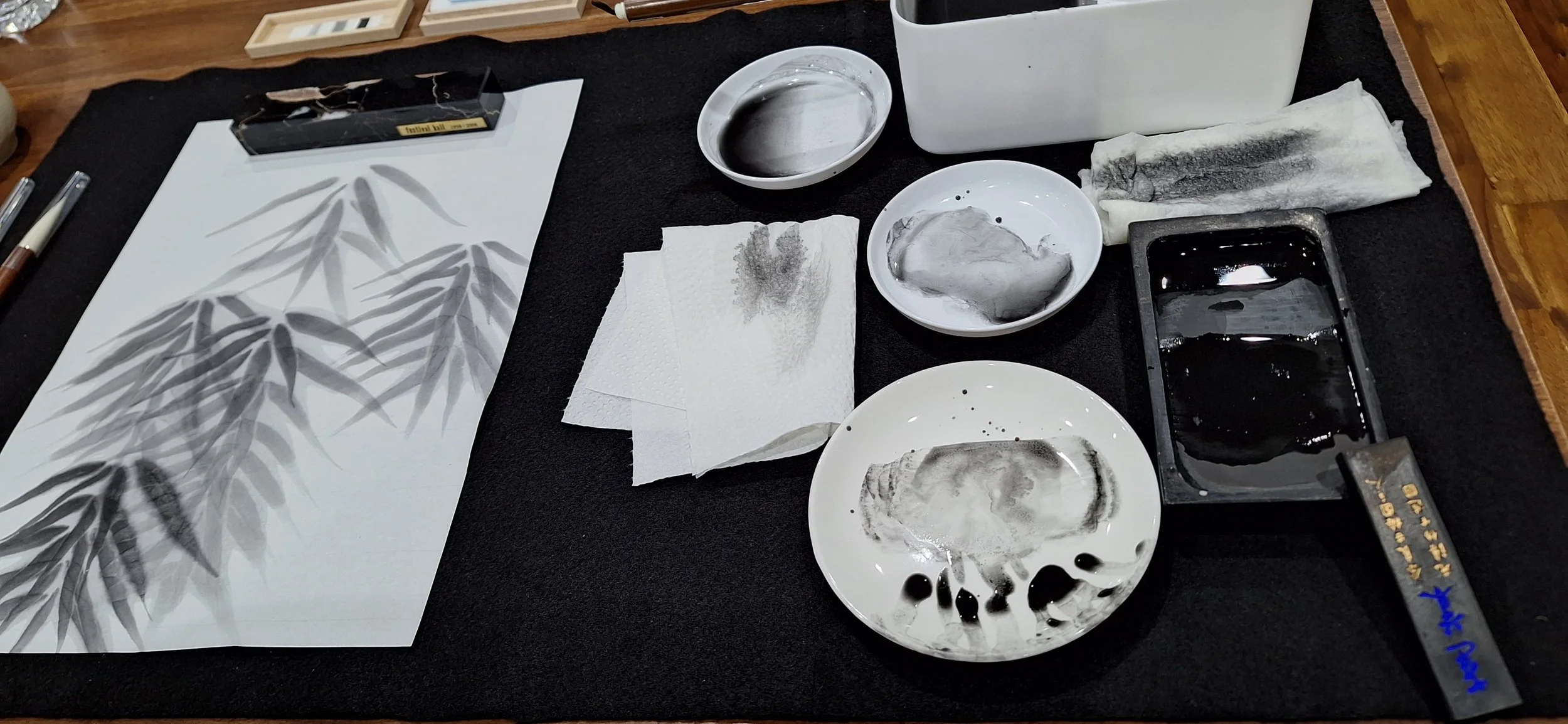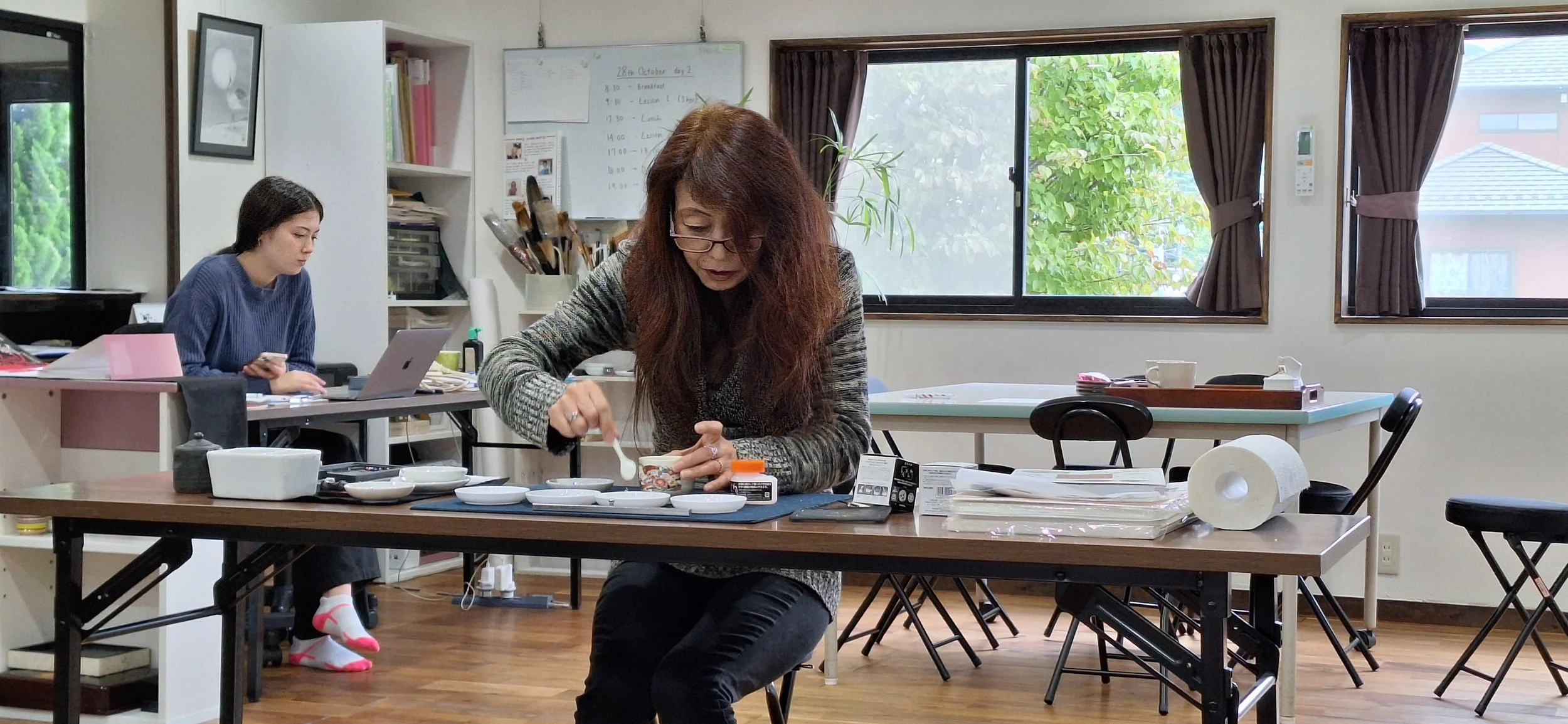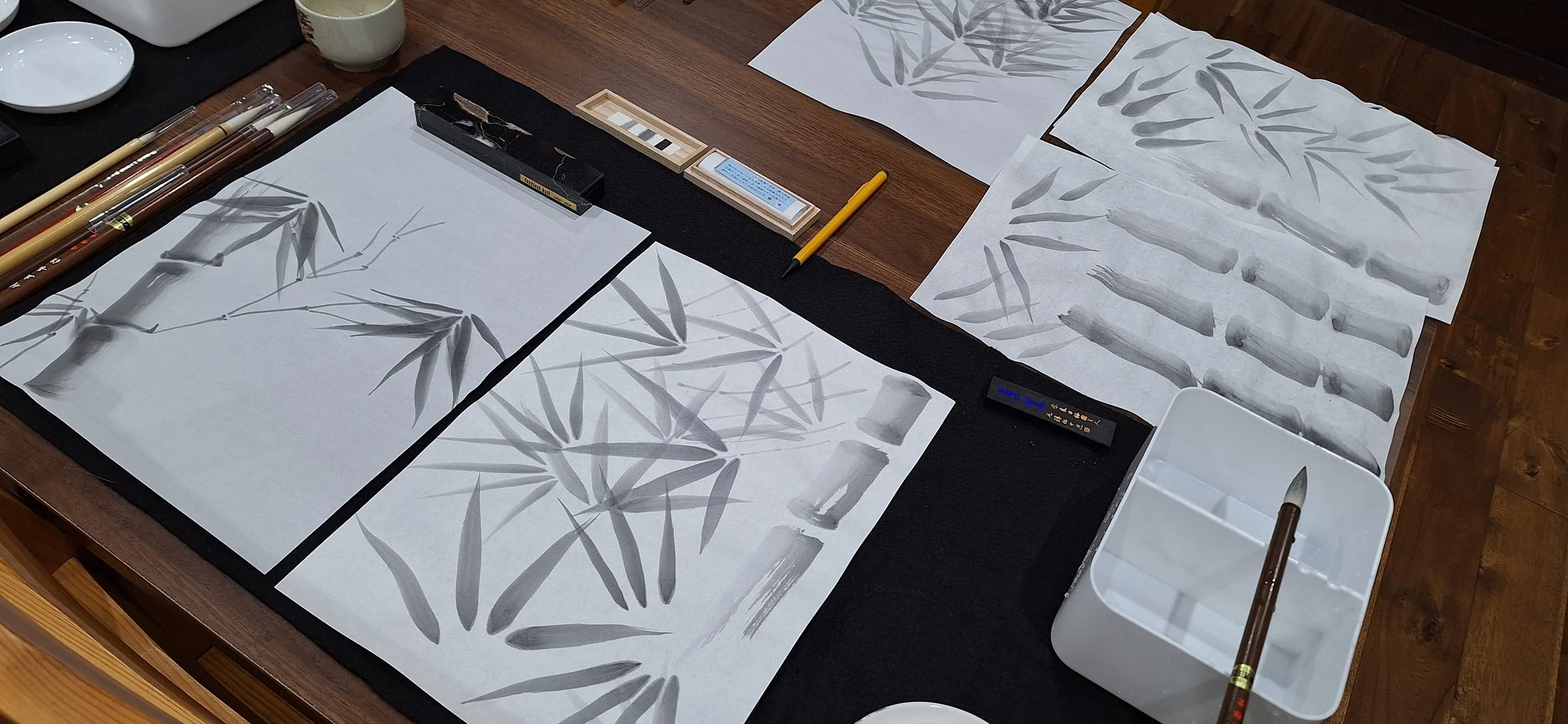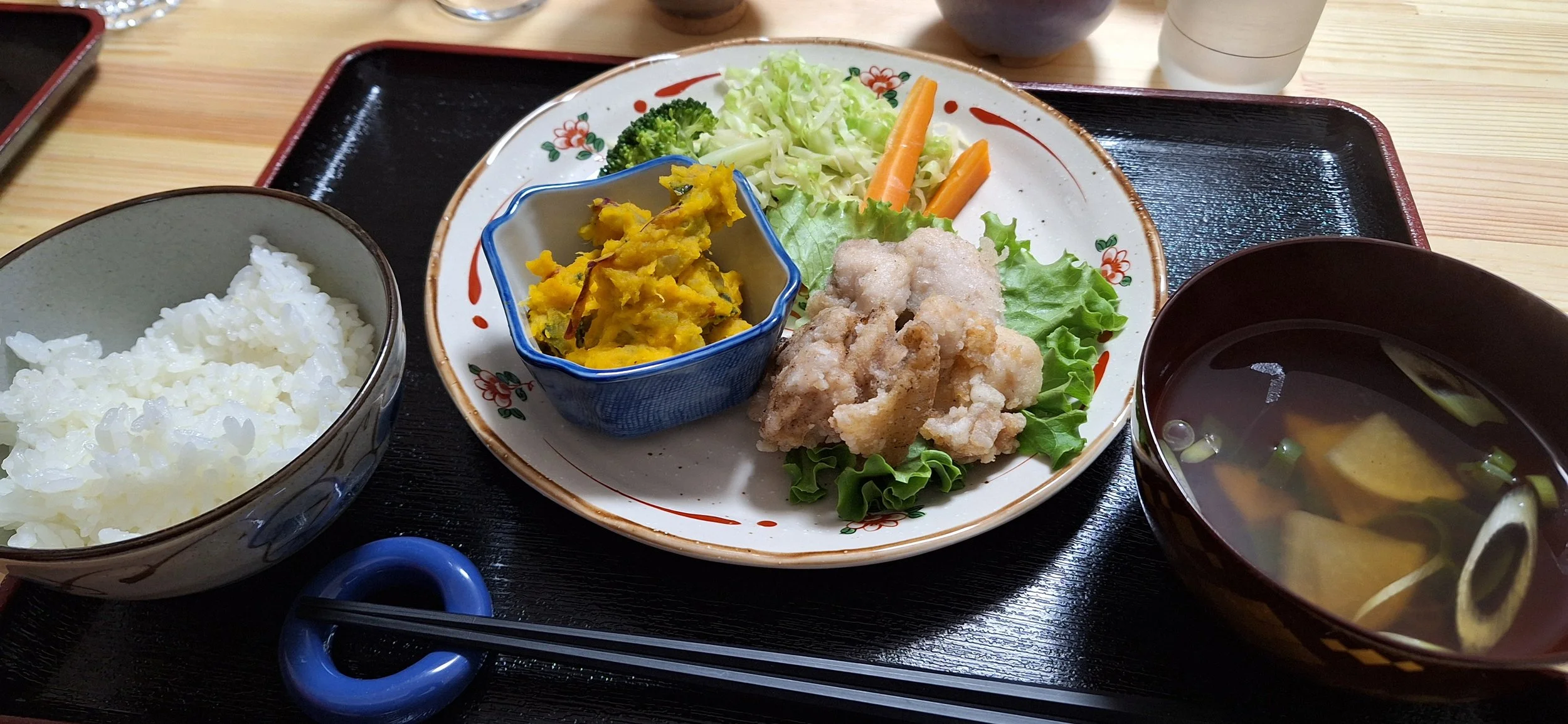Koshu’s Dream House: Chapter 2
After spending several days travelling across Central and Western Honshu, I was now enjoying a new change of pace in rural Yamaguchi.












The tree-covered mountains and scenery really offered a real life Studio Ghibli / Breath of the Wild experience! There were wild koi in the river, chickens foraging freely, little frogs and large toads... The sights and sounds of nature offered a radical contrast to the cities I had just travelled through.
After a brief period settling in and exploring, it was time to have our first lesson!
Lesson One: Covering the basics (bamboo leaves using the chokuhitsu technique). The beautiful ink stick on the right is ground down with water to create the ink. There is also a large water pot, and three small dishes to mix and dilute the inks for the desired shades of ink wash.
Japanese ink painting, or sumi-e 墨絵 is an ancient art form that stems from Zen Buddhism. It is very much about capturing the essence of nature through the energy of each brushstroke, and the importance of the spaces in between, as opposed to painting a realistic representation of an animal, flower, person or landscape.
Some of the other residents on the course were already quite familiar with the techniques. For me, it was a new aesthetic and artistic approach, so I held onto that fact as I practised, and tried not to be too hard on myself for making mistakes. I wasn’t only learning how to create beautiful and complex ink paintings, I was also working through the very real truth that you have to start from somewhere, and that I was a complete beginner.
Despite our different experiences, skills and prior knowledge of sumi-e (or lack of in my case), we all just appreciated the fact that we were learning from Master Koshu. Receiving that hands-on guidance and correction was amazing, especially with the privilege of practising this ancient artform in rural Japan. Through Akemi’s gentle but diligent direction and encouragement, I soon appreciated the learning process and beginners’ mindset.
“Listen to the sound of your brush”
Akemi Lucas preparing shironuki, a whitening agent that when applied to paper, leaves a white mark. Once dried, it repels ink, even when painted over.
We progressed onto learning the sokuhitsu technique to express a bamboo clum (stem), and then applied chokuhitsu to create sharp lines for the branches. It was very satisfying performing each brushstroke, even if some of my branches ended up looking like stick insects!
A lot was achieved in a couple of hours practise!
There is a shop on site which sells all the materials needed for the course, so I arrived armed with lots of yen! Most of the calligraphy and sumi-e paper, brushes, ink and tools were only available in Japan, so to save on shipping costs, it was best to get what I needed there and then.
I have calligraphy brushes, but they vary in quality, and many from my collection are synthetic. It was nice knowing that what I was buying from the shop were genuine, high quality materials. I bought mensou (a thin brush made from weasel hair), sakuyou and tsuketate brushes (a combination of soft, flexible sheep hair and hard deer, horse and racoon dog hair), along with a few different types of paper, from practise sheets to ume paper, which is a good, thick quality for sumi-e specifically, and gasen tenshin, which is suitable for calligraphy, but also for sumi-e. It was lovely to receive tips and advice from Akemi for what I would need, but also from fellow student and friend Emily, who was enthusiastic over the paper’s different characteristics, such as their level of absorbency and texture.
An exquisite “Horai” yuenboku ink stick crafted from a blend of rapeseed or camellia soot and glue with a shiny finish.
It produces a blueish-black hue when ground down with water in an ink stone.
It was fun doing a mini shopping spree, but I knew that there was only so much I could take back home with me, but if I could I would have bought out the shop!
After only just one lesson, I felt I had made good progress. Everyone looked forward to what the rest of the course had to offer, including the food!
A feast for the eyes and the belly! Gluten-free sweet potato and pumpkin salad, white rice, chicken karaage and soy sauce soup.
It would be remiss of me not to mention the meals lovingly prepared at Koshu’s Dream House.
I genuinely miss the food. Everything was made from scratch. It was seasonal and locally sourced, with great consideration taken to cater to all dietary requirements. Lots of planning and preparation went into the breakfast, lunch and dinner menus, so no meal was repeated. Saty-san (Akemi’s sister) ,Leanne-san (Akemi’s daughter), Jun-san, Chiemi-san and Machako-san formed the Dream House Kitchen Team. They all worked hard to make sure everyone was pleased and satisfied.
Anything with pumpkin I adored, but I also loved the freshly made chicken gyoza, matcha and anko red bean bread, chicken katsu curry, and mitarashi dango!
We needed our energy for all the long lessons, sightseeing and other activities planned, so we thanked them profusely and showed our gratitude after each meal.
“Gochisousamadeshita!”
Suitably stuffed (if there were seconds I always accepted), we always had the chance to chat and get to know each other a little better after meals. We all shared a love for Japanese culture. Ali and Emily shared my passion for J-rock and metal, and Debroha had such a deep connection to Japan, visiting on a yearly basis that these islands were practically a second home for her. I enjoyed her deep dives into all her adventures and the friendships she had made along the way.
We all talked about where we lived, so there was a nice cultural exchange about our home towns and local cuisine. Listing potatoes in all their forms was a hot topic at one point… I do love a good jacket potato.
A chill out space and area where we had a lecture on the history of Sumi-e and Japanese calligraphy. Akemi’s beautiful iris artwork hangs in the background above an ikebana arrangement.
On the second night Akemi delivered a lecture. This covered a condensed history of sumi-e and Japanese calligraphy, but she also talked about her personal practise, growth and journey to become a Master. She told us about Sesshu Toyo (c.1420 - 1506), a famous Japanese painter and Buddhist monk from Kyoto, who moved to Yamaguchi to live and work at the age of 45. There were immediate reactions of passion from some of the group who were already familiar with his work, as Akemi told us that we would be visiting his Unkoku-an, one of his former residence on our first sightseeing trip. Akemi also spoke honestly about her late Master Fujimoto Seizan (1919 - 2004), as his words “learn everything” that would be a mantra that she would remind herself of and live by. Through Koshu’s Dream House, Akemi in turn wanted to provide opportunities for us to “learn everything” during our short stay with her, from learning the basics to creating our final and complete paintings, along with experiencing culturally enriching activities.
I will always try my best to remind myself each day of her wisdom, and that was to be appreciative of what we learn and to stop trying so hard.
Sunset over the mountains in Mine, Yamaguchi.
Have you enjoyed my blog so far? If you would like to support me, please consider a donation.
Please visit https://ko-fi.com/phoenixgray to gift as little as £1. You can even leave a message too. All donations go towards the cost of art materials. These blogs are not monetised and all content and art on this site is free to view.
Alternatively, you can promote me for free simply by sharing my blog or website link on your socials. Any online recommendations help me to reach new audiences and in turn get’s me noticed as an artist.
Many thanks!








